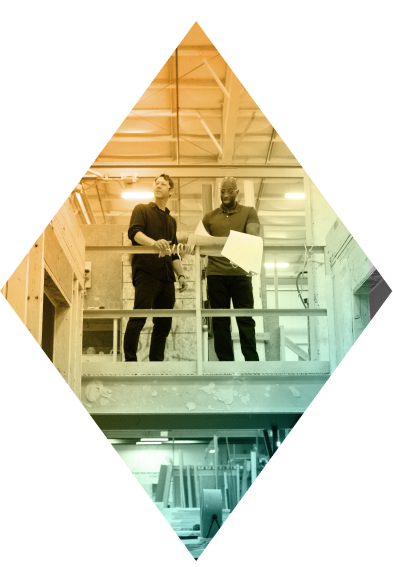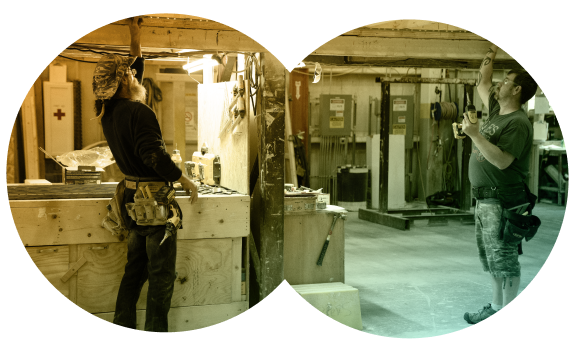It's time to reimagine how we build, with productivity, climate consciousness, and affordable housing top of mind.
All the while, we’re experiencing a global affordable housing crisis and a climate crisis.
And yet, productivity in the building construction industry has remained stagnant.
Most manufacturing industries have evolved over time, increasing in productivity and accountability to people and planet.
An Optimized Modular Construction (OMC) System is a building model that seamlessly integrates the design of a construction facility with that of the high-performance, all-electric multifamily units created within its factory walls.
WHAT IT DOES
An OMC System focuses on the human element – on the welfare of both workers and future building occupants alike. Factories employing OMC System methodologies generate increased productivity while containing cost and maximizing energy performance.
HOW IT WORKS
Energy efficiency and renewable energy elements are incorporated from the earliest phases of building design, and monitoring is thoughtfully integrated, measuring factory performance and building energy performance alike.
Modular construction. Optimized.
Construction in the factory can continue uninterrupted through all seasons and weather. Building in tandem with site preparation and foundation work is also possible, maximizing productivity further still. On well-coordinated projects, construction timelines can be reduced by up to 50%.

Integration of energy efficiency measures at the earliest stages of the building process makes for a proven and predictable order of operations resulting in marked positive results. Unit performance goes up. Energy costs go down.

OMC Systems leverage factory construction’s standardized approach to building and quality control. Deliberate, methodical processes facilitate the seamless integration of energy efficiency measures and the creation of a better product overall.

Time-savings and improved quality both help to contain costs relative to a code-minimum building. Factory construction also minimizes waste and discourages change orders.

The Inflation Reduction Act (IRA) leads the way with billions earmarked for clean energy. Credits are available for commercial building improvements as well as for new home construction meeting ENERGY STAR® home program or DOE Zero Energy Ready Home program requirements.

Streamlined, optimized jobs are transforming the workplace. The addition of on-site resources such as classrooms, conference rooms, cafeterias, and daycare adds considerable value for employers and employees alike, positively impacting productivity, retention, and quality of life.

Benefits of an OMC System
Construction in the factory can continue uninterrupted through all seasons and weather. Building in tandem with site preparation and foundation work is also possible, maximizing productivity further still. On well-coordinated projects, construction timelines can be reduced by up to 50%.

Integration of energy efficiency measures at the earliest stages of the building process makes for a proven and predictable order of operations resulting in marked positive results. Unit performance goes up. Energy costs go down.

OMC Systems leverage factory construction’s standardized approach to building and quality control. Deliberate, methodical processes facilitate the seamless integration of energy efficiency measures and the creation of a better product overall.

Time-savings and improved quality both help to contain costs relative to a code-minimum building. Factory construction also minimizes waste and discourages change orders.

The Inflation Reduction Act (IRA) leads the way with billions earmarked for clean energy. Credits are available for commercial building improvements as well as for new home construction meeting ENERGY STAR® home program or DOE Zero Energy Ready Home program requirements.

Streamlined, optimized jobs are transforming the workplace. The addition of on-site resources such as classrooms, conference rooms, cafeterias, and daycare adds considerable value for employers and employees alike, positively impacting productivity, retention, and quality of life.

Modeled &
measured
Computer simulation and building monitoring allow for feedback and optimization of both the factory and its final product, a high-performance multifamily building.
Modularized
HVAC
in multifamily units
High-efficiency mechanical pods avoid the need for centralized hot water and ventilation systems while helping to achieve energy efficiency goals.
Maximized
in-factory
work
Important components like high-performance building envelopes and solar with unitized storage are installed in the factory rather than on-site.
Integrated energy efficiency & renewable energy
Energy-efficient technology is utilized in place of conventional equipment and systems.
Best practices of an OMC System
Integrated energy efficiency
& renewable energy
Energy-efficient technology is utilized in place of conventional equipment and systems.
Important components like high-performance building envelopes and solar with unitized storage are installed in the factory rather than on-site.
Maximized in-factory work
High-efficiency mechanical pods avoid the need for centralized hot water and ventilation systems while helping to achieve energy efficiency goals.
Modularized HVAC in multifamily units
Modeled & measured
Computer simulation and building monitoring allow for feedback and optimization of both the factory and its final product, a high-performance multifamily building.
Best practices of an OMC System


CHALLENGE
Though an improvement compared to working on-site, most factories are cold in the winter and hot in the summer. In fact, many facilities often lack ventilation beyond an open bay door.
Attracting and maintaining the workforce of the future demands better.
SOLUTION
An OMC System addresses such concerns while adding valuable efficiency benefits and economizing operating costs.
Modeling shows that all-electric, high-performance factories with ventilation are cost-effective to own and operate relative to factories of standard construction.
System spotlight:
Optimizing for
Optimizing for



Electric HVAC
All-electric Equipment
Lighting
Building Envelope
Solar
Hover cursor to explore
Clean, renewable solar energy contributes to business security and resilience while reducing the overhead costs associated with fossil fuels.
Solar

A high-performance envelope efficiently maintains the factory’s indoor climate, thereby avoiding needless energy consumption.
Building Envelope

Power-saving LEDs equipped with programmable timers and/or motion sensors ensure safety while forgoing unnecessary energy consumption by lighting the workspace only when needed.
Lighting

The use of equipment like electric forklifts, variable frequency drive motors, and compressed air tools all serve to reduce power consumption, increasing efficiencies.
All-electric Equipment

Efficient heating, cooling, air exchange, and filtration all contribute to the optimum temperature, humidity, and air quality. This aids in materials handling, safety, and comfort.
Electric HVAC

How an OMC factory achieves a net zero energy balance
How an OMC factory achieves a net zero energy balance
Clean, renewable solar energy contributes to business security and resilience while reducing the overhead costs associated with fossil fuels.
1. Solar

A high-performance envelope efficiently maintains the factory’s indoor climate, thereby avoiding needless energy consumption.
2. Building Envelope

Power-saving LEDs equipped with programmable timers and/or motion sensors ensure safety while forgoing unnecessary energy consumption by lighting the workspace only when needed.
3. Lighting

The use of equipment like electric forklifts, variable frequency drive motors, and compressed air tools all serve to reduce power consumption, increasing efficiencies.
4. All-electric Equipment

Efficient heating, cooling, air exchange, and filtration all contribute to the optimum temperature, humidity, and air quality. This aids in materials handling, safety, and comfort.
5. Electric HVAC

Energy exchange pods are installed in the factory, with off-the-shelf equipment for heating, cooling, ventilation, and hot water.
Mechanical Equipment

By utilizing unitized systems (e.g., hot water) rather than centralized, space is freed up for additional units and on-site work is minimized.
Unitized Systems

Optimized ducting layouts are employed for interfacing air systems with building envelopes. Refrigerant lines are routed from outdoor units, eliminating mateline penetrations.
Ducting Strategies

Superior-quality insulation is installed in the factory.
Building Envelope

A modular roof system enables ease of solar panel installation in-factory while also allowing final, water-tight connections to be made between modules.
Solar & Battery Storage

Modular factories are subject to stringent third-party monitoring of building quality and are required to develop and maintain a Quality Control Protocol.
Quality Assurance & Control

An L-shaped production line of 21 workstations and 7 feeder stations facilitate faster construction timelines, improved quality, reduced waste, and specialized installation of energy efficiency measures.
Production Line

A specialized station fitted for the installation of photovoltaic panels minimizes additional on-site work at the multifamily building’s final location, thereby saving both time and money.
Factory-installed Solar + Storage

A dedicated workstation and quality control process specific to air sealing and superior-quality insulation ensures that the creation of a high-performance building envelope is accomplished in the factory.
Building Envelope

True to classic assembly line methodologies, specialized workstations maximize productivity and the integration of energy efficiency and renewables while fostering consistency and simplifying quality control.
Specialized Station

A workstation devoted to installation of high-efficiency mechanical pods maximizes work performed in the controlled factory setting and achieves energy efficiency goals.
HVAC Pods & Storage

Integrated DES creates digital models of real-world factory environments. Lean principles like waste reduction, line balancing, and just-in-time concepts are simulated in advance to de-risk line changes.
Discrete Event Simulation (DES)

Early-stage building energy modeling helps the design team better integrate energy efficiency and renewable energy features into the process of multifamily construction design.
Building Performance

Efficient heating, cooling, air exchange, and filtration all contribute to the optimum temperature, humidity, and air quality. This aids in materials handling, safety, and comfort.
Electric HVAC

The use of equipment like electric forklifts, variable frequency drive motors, and compressed air tools all serve to reduce power consumption, increasing efficiencies.
All-electric Equipment

Power-saving LEDs equipped with programmable timers and/or motion sensors ensure safety while forgoing unnecessary energy consumption by lighting the workspace only when needed.
Lighting

A high-performance envelope efficiently maintains the factory’s indoor climate, thereby avoiding needless energy consumption.
Building Envelope

Clean, renewable solar energy contributes to business security and resilience while reducing the overhead costs associated with fossil fuels.
Solar

Heading 1
Heading 1
Heading 1
Heading 1
Heading 1
Heading 1
Paragraph 1
Paragraph 2
Paragraph 3
OMC Systems and the future
Read the whole report for a comprehensive understanding of OMC Systems. You'll find the complete case studies and more here:
Of course, we'd love the opportunity to speak with you.
Call the number below to connect with a member of the VEIC team.
Of course, we'd love the opportunity to speak with you. Call the number below to connect with a member of the VEIC team.

Factory-installed Solar + Storage
Building Envelope
HVAC Pods & Storage
Building Performance
Hover cursor to explore
Early-stage building energy modeling helps the design team better integrate energy efficiency and renewable energy features into the process of multifamily construction design.
Building Performance

Integrated DES creates digital models of real-world factory environments. Lean principles like waste reduction, line balancing, and just-in-time concepts are simulated in advance to de-risk line changes.
Discrete Event Simulation (DES)

A workstation devoted to installation of high-efficiency mechanical pods maximizes work performed in the controlled factory setting and achieves energy efficiency goals.
HVAC Pods & Storage

True to classic assembly line methodologies, specialized workstations maximize productivity and the integration of energy efficiency and renewables while fostering consistency and simplifying quality control.
Specialized Station

A dedicated workstation and quality control process specific to air sealing and superior-quality insulation ensures that the creation of a high-performance building envelope is accomplished in the factory.
Building Envelope

A specialized station fitted for the installation of photovoltaic panels minimizes additional on-site work at the multifamily building’s final location, thereby saving both time and money.
Factory-installed Solar + Storage

Modular factories are subject to stringent third-party monitoring of building quality and are required to develop and maintain a Quality Control Protocol.
Quality Assurance & Control

How an OMC System streamlines factory layout and function
How an OMC System streamlines factory layout and function
Early-stage building energy modeling helps the design team better integrate energy efficiency and renewable energy features into the process of multifamily construction design.
1. Building Performance

Integrated DES creates digital models of real-world factory environments. Lean principles like waste reduction, line balancing, and just-in-time concepts are simulated in advance to de-risk line changes. Read the case study here or the Research paper here.
2. Discrete Event Simulation (DES)

A workstation devoted to installation of high-efficiency mechanical pods maximizes work performed in the controlled factory setting and achieves energy efficiency goals.
3. HVAC Pods & Storage

True to classic assembly line methodologies, specialized workstations maximize productivity and the integration of energy efficiency and renewables while fostering consistency and simplifying quality control. Read the case study here.
4. Specialized Station

A dedicated workstation and quality control process specific to air sealing and superior-quality insulation ensures that the creation of a high-performance building envelope is accomplished in the factory.
5. Building Envelope

A specialized station fitted for the installation of photovoltaic panels minimizes additional on-site work at the multifamily building’s final location, thereby saving both time and money.
6. Factory-installed Solar + Storage

Modular factories are subject to stringent third-party monitoring of building quality and are required to develop and maintain a Quality Control Protocol. Read the case study here.
7. Quality Assurance
& Control

Key features of an OMC multifamily building
OMC Systems simultaneously consider both the design and manufacturing
of the multifamily buildings a factory is fitted to build. This streamlines the incorporation of building envelope strategies, mechanical equipment solutions, smart controls, and integration of renewables and storage systems. Read the full report here.
A modular roof system enables ease of solar panel installation in-factory while also allowing final, water-tight connections to be made between modules.
1. Solar & Battery Storage

Superior-quality insulation is installed in the factory.
2. Building Envelope

Optimized ducting layouts are employed for interfacing air systems with building envelopes. Refrigerant lines are routed from outdoor units, eliminating mateline penetrations.
3. Ducting Strategies

Energy exchange pods are installed in the factory, with off-the-shelf equipment for heating, cooling, ventilation, and hot water.
4. Mechanical Equipment


Mechanical Equipment
Unitized Systems
Ducting Strategies
Building envelope
Solar & Battery Storage
Hover cursor to explore
A modular roof system enables ease of solar panel installation in-factory while also allowing final, water-tight connections to be made between modules.
Solar & Battery Storage

Superior-quality insulation is installed in the factory.
Building Envelope

Optimized ducting layouts are employed for interfacing air systems with building envelopes. Refrigerant lines are routed from outdoor units, eliminating mateline penetrations.
Ducting Strategies

Energy exchange pods are installed in the factory, with off-the-shelf equipment for heating, cooling, ventilation, and hot water.
Mechanical Equipment

Key features of an OMC multifamily building
OMC Systems simultaneously consider both the design and manufacturing
of the multifamily buildings a factory is fitted to build. This streamlines the incorporation of building envelope strategies, mechanical equipment solutions, smart controls, and integration of renewables and storage systems. Read the full report here.
Energy exchange pods are installed in the factory, with off-the-shelf equipment for heating, cooling, ventilation, and hot water.
Mechanical Equipment

By utilizing unitized systems (e.g., hot water) rather than centralized, space is freed up for additional units and on-site work is minimized.
Unitized Systems

Optimized ducting layouts are employed for interfacing air systems with building envelopes. Refrigerant lines are routed from outdoor units, eliminating mateline penetrations.
Ducting Strategies

Superior-quality insulation is installed in the factory.
Building Envelope

A modular roof system enables ease of solar panel installation in-factory while also allowing final, water-tight connections to be made between modules.
Solar & Battery Storage

Modular factories are subject to stringent third-party monitoring of building quality and are required to develop and maintain a Quality Control Protocol. Read the case study here.
Quality Assurance & Control

An L-shaped production line of 21 workstations and 7 feeder stations facilitate faster construction timelines, improved quality, reduced waste, and specialized installation of energy efficiency measures.
Production Line

A specialized station fitted for the installation of photovoltaic panels minimizes additional on-site work at the multifamily building’s final location, thereby saving both time and money.
Factory-installed Solar + Storage

A dedicated workstation and quality control process specific to air sealing and superior-quality insulation ensures that the creation of a high-performance building envelope is accomplished in the factory.
Building Envelope

True to classic assembly line methodologies, specialized workstations maximize productivity and the integration of energy efficiency and renewables while fostering consistency and simplifying quality control. Read the case study here.
Specialized Station

A workstation devoted to installation of high-efficiency mechanical pods maximizes work performed in the controlled factory setting and achieves energy efficiency goals.
HVAC Pods & Storage

Integrated DES creates digital models of real-world factory environments. Lean principles like waste reduction, line balancing, and just-in-time concepts are simulated in advance to de-risk line changes. Read the case study here or the Research paper here.
Discrete Event Simulation (DES)

Early-stage building energy modeling helps the design team better integrate energy efficiency and renewable energy features into the process of multifamily construction design.
Building Performance

Efficient heating, cooling, air exchange, and filtration all contribute to the optimum temperature, humidity, and air quality. This aids in materials handling, safety, and comfort.
Electric HVAC

The use of equipment like electric forklifts, variable frequency drive motors, and compressed air tools all serve to reduce power consumption, increasing efficiencies.
All-electric Equipment

Power-saving LEDs equipped with programmable timers and/or motion sensors ensure safety while forgoing unnecessary energy consumption by lighting the workspace only when needed.
Lighting

A high-performance envelope efficiently maintains the factory’s indoor climate, thereby avoiding needless energy consumption.
Building Envelope

Clean, renewable solar energy contributes to business security and resilience while reducing the overhead costs associated with fossil fuels.
Solar

